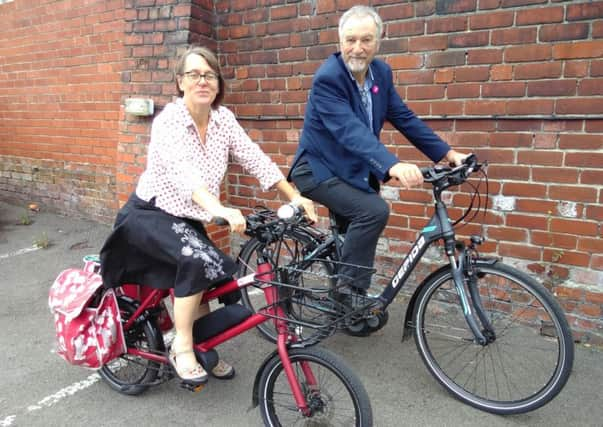Column: Do the environment a favour and get out and about on an electric bike


Judging by how often I am asked about e-bikes lately, folk are catching on to their potential as a viable, green and fun option for people of all persuasions to be less vehicle dependent for appropriate journeys. For years, Chris and I have pedalled journeys long and short on ‘normal’ bikes, initially trying e-bikes simply out of curiosity, but quickly realizing how much fun, how convenient and how sensible they are as an everyday utilitarian transport option.
In hilly, traffic choked Sheffield, where they achieve high average speeds, e-bikes are often quicker than the car in city/urban conditions. However, if you find yourself considering one, e-bike terminology and the range available is bewildering.
Advertisement
Hide AdAdvertisement
Hide AdSo what is an ‘e-bike’? An e-bike is effectively a normal sturdy bicycle with an electric motor and a battery. Nowadays nearly all are ‘Pedelecs’, only kicking in when you pedal, and cutting off assistance above 15.5mph. (You can then pedal faster than 15.5mph under your own power as on a normal bike, though of course you have the extra 6-8Kg of e-bike kit to haul along, plus a bit of motor drag on some models, so mostly you find yourself bowling along at 12-16mph in practice.)
The UK and EU legal rated power for an e-bike motor for public road use is 250 watts, any more and it legally ceases to be classed as a bicycle and becomes a moped, requiring a licence, helmet, insurance etc., and any illegal acts committed on the bike then applying to your vehicle licence. In practice, all mainstream retailers sell UK compliant 250W bikes. ‘Twist and Go’ e-bikes made post Jan 2016; with a throttle that works above 4mph are a boon but also a grey area. Being classed as a bicycle, helmet wearing is not a legal requirement on e-bikes, so this is a matter of choice and a judgement I make based on conditions. We do however prioritise bright clothing and having bright lights switched on both day and night, a la Volvo.
Why mightyou think of buying an e-bike? Everyday e-biking is fun, quick, convenient, cheap (50 miles for a few pence) and can help fitness. We have noticed feeling more confident than on un-powered bikes at times, with the power and presence to be more part of the traffic. Everyday journeys for work, heavy shopping and pubbing that would have involved the queues/parking hassles of using a vehicle, or hanging around for public transport, are now undertaken with ease and convenience. On e-bikes, even the ‘weather’ doesn’t discourage, and statistically we will live longer and better due to cardiac exercise, and research even shows we are breathing less pollution than when sat in traffic in a vehicle. E-bike power is particularly suitable for shifting heavy or bulky stuff with ‘cargo’ bikes. Our small wheel ‘Butchers bike’ style Orbea ‘Katu’ is proving ideal for differing height riders who want to share a nimble, versatile ‘do it all’ urban e-bike that in most respects supersedes a small car.
The e-bike market is opening up fast lately, and if you are curious about or considering buying an e-bike check out try e-Bike tips to keep up to the minute. Take a look at forums and publications like Pedelecs and A to B for general discussions and reviews. Dealer’s websites like E-Bikes Direct and Electric Bike Sales offer further helpful discussions about e-bikes and also for ideas on makes and prices.
Advertisement
Hide AdAdvertisement
Hide AdWhat should you consider when choosing an e-bike? Consider what you want it for and where. There are two main types of e-bike, those powered by electric motors in the front or the rear wheels (Hub drive) and those with the motor positioned down in the frame and working upon the pedal axle – Crank (aka Centre, Chain or Mid) drive. Our e-bikes are this latter type, and we use them as everyday transport for short, often well-loaded utility journeys in hilly Sheffield. Others, often those who would not normally cycle any significant distance, if at all, choose e-bikes for longer and less loaded recreational rides of 50 miles or more and love the feeling of easily getting out along their local roads. Also exploring on such as Sustrans trails and, for cycle journey planning, Cycle Streets and locally, Sheffield cycle routes of course.
In hilly areas a Crank drive is more effective, as the electric motor drives through the bikes gears as it helps you pedal, and with the right gear selected the motor is kept running at its optimum torque and speed, so less likely to strain on steep/long climbs. (Torque = pulling/climbing power, expressed in Nm. All 250w e-bike motors can give varying levels of torque, set by the manufacturer. 50Nm is the minimum needed for hilly areas.)
Where could I try and buy one, and how much should I spend? Websites like ‘ebiketips’ are a great source of info and e-bike reviews, and several bike shops in our area are now selling and servicing e-bikes. Well made, reliable models start at around £1,200, and £1500-£2000 will buy you a lighter and more natural feeling e-bike with high quality parts and equipment. Whilst running costs are miniscule compared to a vehicle, this is quite an initial outlay, so maybe borrow an e-bike for a trial period.
So now that you are armed with this information go on – free your wallet and your spirit, do our great city a favour and give e-biking a go.